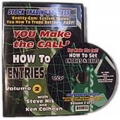TGC - The Art of Negotiating the Best Deal (Total size: 257.8 MB Contains: 7 files)
-250x250.jpg) Click to enlarge |
|
Professor Seth Freeman is an adjunct professor at New York University Stern School of Business and at Columbia University. He has taught negotiation, conflict management, and related subjects there since the 1990s. He holds a B.A. in Economics from Cornell University and a J.D. from The University of Pennsylvania Law School.
A highly rated and popular teacher, Professor Freeman has taught negotiation around the world for many years, including at graduate schools in China and France. He also routinely trains business executives, engineers, law students, and United Nations diplomats.
Professor Freeman is an experienced corporate lawyer who practiced with major New York law firms for several years, and he is a trained mediator. His academic research focuses on ways to cope with trust problems in public and private life.
Professor Freeman’s insights on negotiation have been featured on Bloomberg TV and in The New York Times, The Washington Post, USA TODAY, and other major media outlets. He is the author of The Ready and Able Negotiator: How to Get Set for Any Negotiation with I FORESAW IT, the Breakthrough Preparation Tool.
Practically everything we do in life involves negotiation. Many important issues—the political future of nations, the scope of business, the purchase of a house—hinge on negotiation. But negotiation is also an integral part of our everyday lives, whether you are resolving a quarrel, creating a family budget, or simply deciding where to eat lunch. Yet it’s easy to believe we’re usually at a disadvantage—that others are born negotiators, while we are not.
Nothing could be further from the truth. Negotiation is a skill that just about everyone can learn to do well. Some people enjoy it. Others do not. But everyone can cultivate it and learn how to handle common challenges such as these:
- Salary negotiations: Few situations are as awkward as salary negotiations when you’re being offered a new job. The employer has the upper hand, but there are reasonable steps you can take to ensure that you are treated fairly and get the going rate for your position.
- Sharp tactics: Aggressive negotiators are often not as sharp as they seem, since many rely on standard tricks that are easy to spot—if you know what to look for. Be alert for nibbling, limited authority, and double-talk tactics, among other gambits, and know how to counter them.
- Haggling: Haggling is what many people hate about negotiation. But it’s possible to turn a win/lose confrontation into a mutually satisfying agreement by focusing on the interests of the two sides, which can be complementary.
Good negotiating goes beyond succeeding in the marketplace; these skills are crucial for solving conflicts of all types, getting fractious groups to work together, counseling friends in distress, persuading people to give to a charity, and generally getting anyone to accept your point of view—and they enable you to do it in ways that enhance rather than strain relationships.
Wouldn’t a course that equips you with such valuable knowledge pay for itself many times over?
The Art of Negotiating the Best Deal is exactly that course, taught by an expert negotiator, mediator, business school teacher, and former corporate attorney: Seth Freeman, an adjunct professor at New York University Stern School of Business and at Columbia University. In 24 engaging and practical lectures, Professor Freeman teaches you how to approach all phases of a negotiation and deal with a wide range of problems. You’ll learn how to negotiate effectively in both competitive and collaborative situations, always being “hard on the problem and soft on the person”—which is the key to achieving a mutually beneficial outcome.
A Negotiator’s Play-by-Play
Preparation is all-important for successful negotiating. But where do you begin, what do you cover, and how do you organize your time, which may be running out? Professor Freeman structures The Art of Negotiating the Best Deal around a mnemonic device that can serve you like a wise old friend in any negotiation situation.
Fittingly, the mnemonic is I FORESAW IT—each of the 10 letters standing for a word or short phrase that, together, guide you in assembling the strongest possible case. After taking this course, you will understand how to use the I FORESAW IT framework to sketch out a coherent and flexible bargaining strategy, on very short notice if necessary.
Among the elements of I FORESAW IT are these:
- Options: You don’t have to take “no” for an answer when you’re working toward a deal. By coming up with creative options—innovative deal terms—you have a good chance of satisfying both your needs and your counterpart’s.
- Alternatives to agreement: Determine your best alternative to a negotiated agreement (BATNA). This gives you an exit strategy if the other’s offer seems too harsh. Also consider your worst alternative (WATNA), so that you don’t court disaster by overestimating your strength.
- Independent criteria: Identify objective benchmarks—for example, the Blue Book’s report on the market value of a car, or a leading publication’s salary survey covering jobs for someone with your qualifications—that can support what your negotiation is trying to achieve.
These and seven other steps are key ideas that skilled negotiators explore to prepare for important talks. Professor Freeman created the I FORESAW IT mnemonic based on social science research, experts’ accounts, and his extensive negotiating experience, and he illustrates each of the ideas with memorable anecdotes. Some concern major negotiations gone horribly wrong—as when famed industrialist Andrew Carnegie violated a cardinal rule by lowballing himself, asking for far less than his counterpart, J. P. Morgan, was prepared to offer. Others are about triumphs—as when a student’s research helped her persuade a reluctant corporate donor to give five times more to her charity than it had before.
Object Lessons in Negotiation
Stories, says Professor Freeman, have an almost magical ability to engage the listener, illustrate ideas, and stay in the mind. Therefore, The Art of Negotiating the Best Deal features scores of real-life incidents that teach powerful and memorable lessons. These object lessons in negotiation include these:
- Don’t be greedy: Sports agent Bob Woolf represented some of the most celebrated players of his day. But his practice was to stop short of getting the maximum for his clients. Why? “It’s possible to push the price so hard, create such antagonism, that the last 10% really isn’t worth it,” said Woolf.
- Think beyond the negotiating room: Sometimes an impasse can be resolved by bringing new players or other factors into the negotiation. Learn how this insight helped one passenger rescue a planeload of desperate fellow passengers, who had been waiting hours to dock at their gate in Detroit during a blizzard.
- Solve the trust problem: The fractious young United States was on the verge of disintegration in 1787 when state delegates met to negotiate a new compact. The resulting U.S. Constitution incorporated a host of trust mechanisms that bound the nation together, while creating a unique blend of state autonomy and federal power.
Some of the most famous negotiations have happened on the world stage, pitting the competing interests of nations against each other. These riveting talks highlight important principles. You’ll hear about the bargaining breakthroughs that led to the Camp David Accords and the resolution of the Cuban missile crisis. You’ll also hear how a courageous U.S. Army general persuaded his superior to overcome great misgivings and let him land with the first wave of troops during D-Day. Each of these negotiations hinged on an insight that can be put to good use when you next sit down to negotiate.
Knowledge is power, and The Art of Negotiating the Best Deal gives you a potent set of tools to serve your interests, resolve disagreements, and advance causes that you hold dear in respectful, principled ways. What could be more useful than that?
.jpg)
Digital Delivery : Shared Through Google Drive/Mega
===================
❏Please leave your email address once you have made payment
❏Files will be delivered through Google Drive/Mega
❏Any problems will be addressed immediately
❏Links will be sent in less than 12 hours
.jpg)
Delivery to your PayPal email address within 24 Hours of payment confirmation.
Completing units:
TGC - The Art of Negotiating the Best Deal (Total size: 257.8 MB Contains: 7 files)
To buy without signing in contact us here: CHAT
Market Sales Price: $599,but we sell lot more lower than that to share the opportunity with you!
Our Policies
A. Product Quality
- We ensure that the quality of the course is good, and we update them regularly to help you keep update.
- If there is a problem you can not use, please let us know so we can fix it soon or if there is any notification, we will inform you immediately.
B. Shipping Method
- After receiving your payment, we will send you a link to access and download the course. If our team is not in the office, please wait for us about 8 hours to come back.
C. Refund Policy
We do not accept refund after you got the link and download the course.
We will refund your money in case of:
- Item is not as described
- Item doesn’t work the way it should
- Item support extension can’t used
Serving Professional Traders Since 2008
Once purchased I will email you the files within 20 minutes and not more than 48 hours to your email, if there a delay, please be patience receiving your files
Your Review: Note: HTML is not translated!
Rating: Bad Good
Enter the code in the box below:

 Categories
Categories Information
Information Specials
Specials




-38x38.jpg)

-38x38.jpg)
-38x38.jpg)
-38x38.jpg)
-38x38.jpg)
-38x38.jpg)

-38x38.jpg)



-38x38.jpg)


-38x38.jpg)
-38x38.jpg)
-38x38.jpg)
 Featured
Featured

























 Shopping Cart
Shopping Cart Bestsellers
Bestsellers






-38x38.jpg)































-38x38.jpg)








